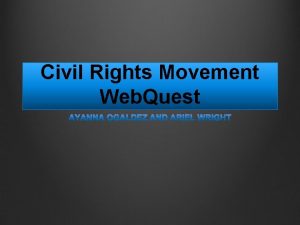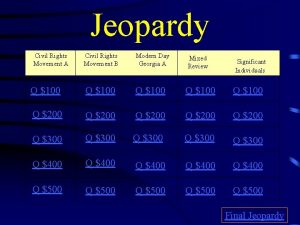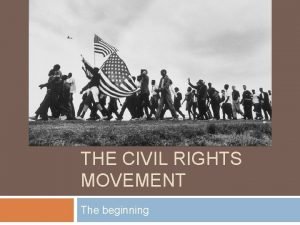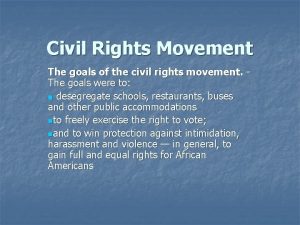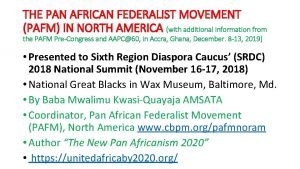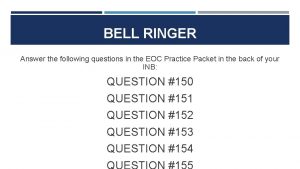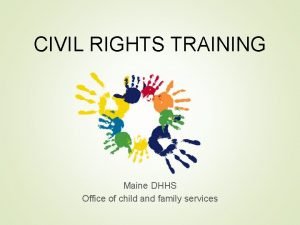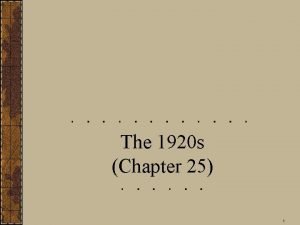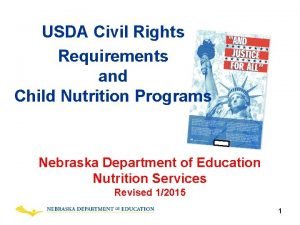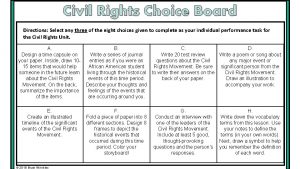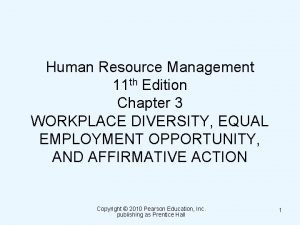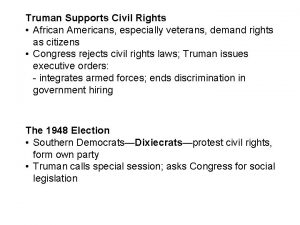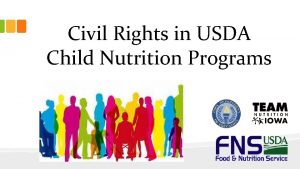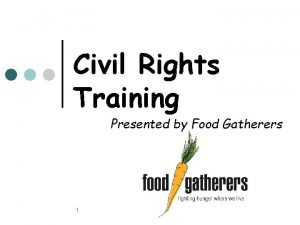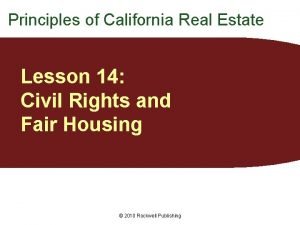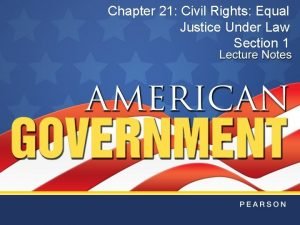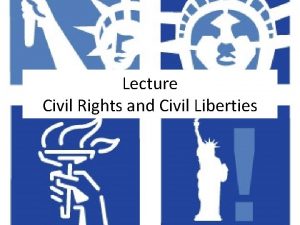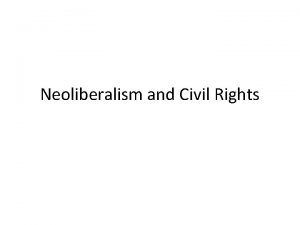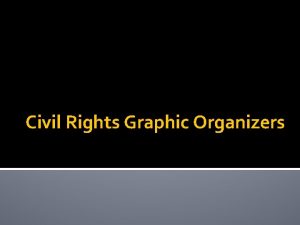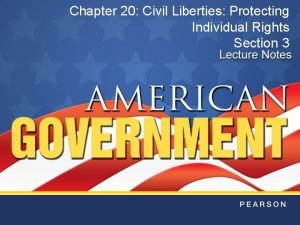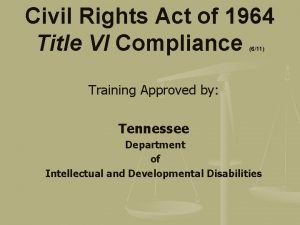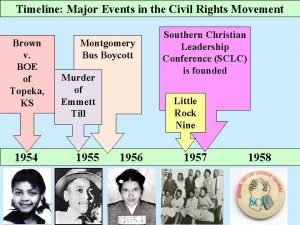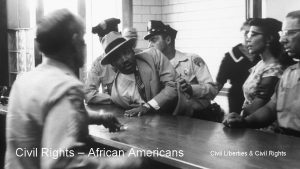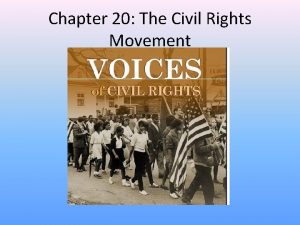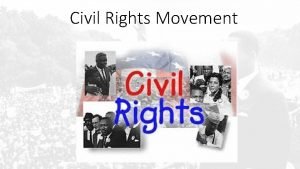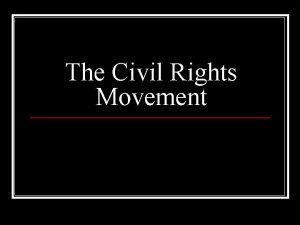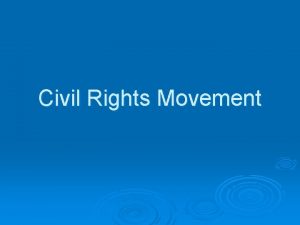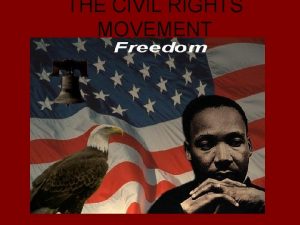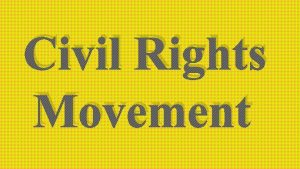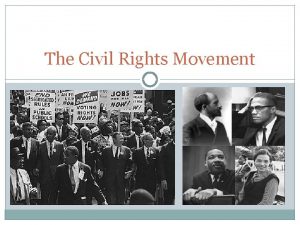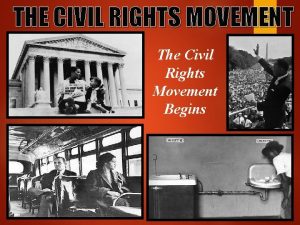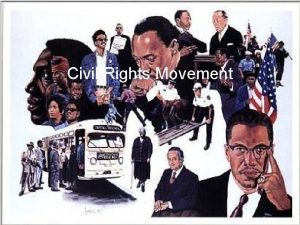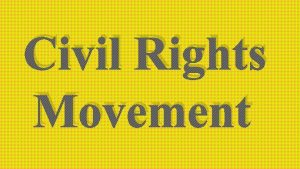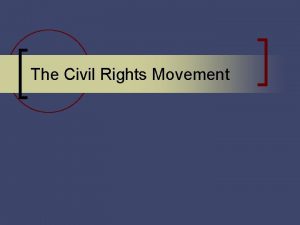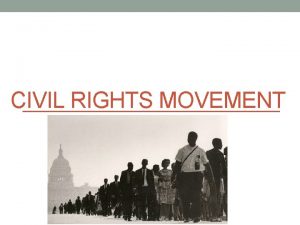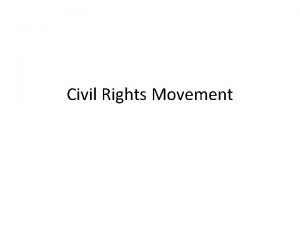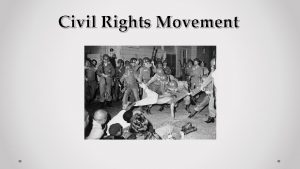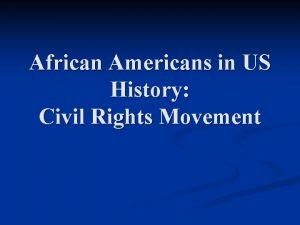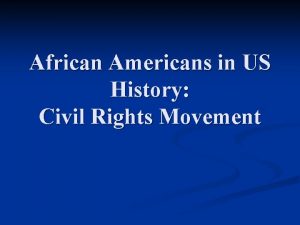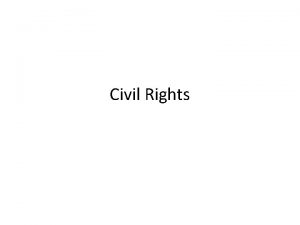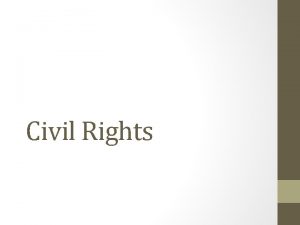Civil Rights Movement PostWWII African Americans grew dissatisfied






























- Slides: 30

Civil Rights Movement

Post-WWII • African Americans grew dissatisfied with their second-class status after WWII – Risked their lives defending freedom abroad • Civil Rights Movement-a broad and diverse effort to attain racial equality http: //www. history. com/shows/america-the -story-of-us/videos/blacks-in-themilitary#blacks-in-the-military

Segregation divides America • Jim Crow laws-enforced strict separation of the races in the South – Schools, hospitals, transportation, & restaurants • De jure segregationimposed by law • 1896 Plessy vs. Ferguson”Separate but equal”

Segregation in the North • De facto segregation: segregated by unwritten custom or tradition, face of life • Blacks were denied housing in many neighborhoods and faced discrimination in employment (NORTH)

The Impact of Segregation • African Americans received low-paying jobs • Higher rates of poverty and illiteracy • Lower rates of homeownership and life expectancy • Couldn’t vote in the south

The Civil Rights Movement Grows • Congress of Racial Equality (CORE): became convinced to use non-violent methods to gain civil rights (est. 1948) – Organized Protests in northern cities • Jackie Robinson (1947) • President Truman used his executive power to order the desegregation of the military (1948)

NAACP Challenges Segregation • NAACP became the largest and most powerful civil rights organization (1950’s) • Thurgood Marshall-headed the team that challenged the legality of segregation

Brown vs. Board 1954 • NAACP challenged the “separate but equal” ruling • The Supreme Court agreed with NAACP argument that segregated public education violated the U. S. Constitution • Effects: – Great impact since it touched so many Americans – Opposition to the ruling declared that the South would not be integrated (White Citizens Council) http: //www. history. com/videos/brown-vsboard-of-education-separate-is-notequal#brown-vs-board-of-educationseparate-is-not-equal

Little Rock Nine (1957) • President Eisenhower sent federal troops to Little Rock to protect the African American students and to enforce Brown vs. Board • For the entire school year, federal troops stayed in Little Rock escorting the students to and from school http: //www. history. com/videos/littlerock-9#little-rock-9

Effects of Little Rock Nine • It demonstrated that the President would not tolerate open defiance of the law • However, most southern states found ways to resist desegregation and it would take years before black and white children went to school together • June 1963 - George Wallace & U. of Ala.

Montgomery Bus Boycott • Rosa Parks actions transformed the movement (Dec. 1955) • NAACP began preparing a legal challenge • Rise of MLK: urged non-violence • Boycott lasted a year • In 1956 the Supreme Court ruled the Montgomery bus segregation law was unconstitutional

Effects of the Boycott and the Supreme Court Victory • Revealed the power African Americans could have if they joined together • King established the Southern Christian Leadership Conference (SCLC) – Advocated nonviolent resistance to fight injustice

Freedom rides Summer 1961 • Test the federal government’s willingness to enforce that segregation on interstate buses was illegal (Boynton v. Virginia 1960) • En route, they defied segregation codes • In Alabama firebombed one bus and attacked the riders of the second bus

Effects of the Freedom Ride • Kennedy takes action • Federal Transportation Commission issued an order mandating the desegregation of interstate transportation • Civil rights activists achieved their goal and that intimidation would not defeat them http: //video. pbs. org/video/1574363015/


Sit-ins • Four black students at North Carolina sat down in a white diner and were told that they would not be served (First-Feb. 1960) • Sit ins became a new way to protest segregation of public facilities

Focus on Birmingham • Letter from Birmingham Jail by King (Apr. 1963) • September 15, 1963 - A bomb blast at the Sixteenth Street Baptist Church in Birmingham, Alabama, kills four African. American girls during church services. At least 14 others are injured in the explosion • Freedom marches: schoolchildren joined the demonstrations • Many Americans were shocked by the news coverage of nonviolent protestors set upon by dogs and jets of water • Kennedy approves civil rights bill

March on Washington (1963) • To put pressure on Congress to pass the new civil rights bill • Drew more than 200, 000 • MLK-”I have a dream” • One of the largest political demonstrations • A model for peaceful protest http: //www. history. com/videos/martin-lutherking-jr-leads-the-march-on-washington#martinluther-king-jr-leads-the-march-on-washington

Civil Rights Act of 1964 • The act banned segregation in public accommodations • Gave the federal government the ability to desegregate schools • Prosecute individuals who violated people’s civil rights • Outlawed discrimination in employment • Established the Equal Employment Opportunity Commission (EEOC) http: //www. history. com/videos/civil-rights-act-of-1964#civil-rights-act-of-1964

The Push for Voting Rights • Literacy tests • Poll taxes • Intimidation All kept blacks from voting

Voting Rights Act of 1965 • Spurred by actions of protesters and the President, Congress passed the act • It banned literacy tests and empower the federal gov’t to oversee voting registration • By 1975, Congress extended to Hispanic voters • Black participation jumped from 7% in 1964 to 70% in 1986

The Riots • Frustration over discrimination and poverty • Worst in Newark, New Jersey and Detroit, Michigan in the summer of 1967 • Blacks using violence against police and white business owners in black neighborhoods

The Kerner Commission • It concluded racial discrimination as the cause of the violence • They recommended by extending federal programs to Urban black neighborhoods • Controversy surrounding the Commission • Johnson did not follow up

Malcolm X • Influenced by race riots • Difficult childhood • While in jail, converted to the Nation of Islam – Strict rules of behavior, no drugs or alcohol, and demanded a separation of the races

Malcolm X • He became the Nation of Islam’s most prominent minister – However, he broke away and formed his own – Three members were later convicted of assassinating Malcolm • After his pilgrimage to Mecca, Malcolm was more willing to consider limited acceptance of whites

“Black Power” • Stokley Carmichael’s definition: it meant African Americans should collectively use their economic and political muscle to gain equality – Institutional Racism http: //www. history. com/videos/stokelycarmichael#stokely-carmichael

Black Panthers • Symbol of young militant African Americans • Protected urban neighborhoods from police abuse • Created antipoverty programs • Stokely was “honorary Prime Minister”

MLK’s final days • Understood the anger and frustration of many urban African Americans • Disagreed with the call for “black power” • King’s assassination triggered riots in more than 100 cities (Apr. 1968) • 2 months later Robert Kennedy was assassinated

Significant Gains • Eliminated legal or de jure segregation • Knocked down barriers of voting and political participation for African Americans • Poverty rates fell • Increase in the number of African Americans high school graduates • Appointment of Thurgood Marshall as the first African American Supreme Court Justice in 1967 • Fair Housing Act

Controversial Issues • Affirmative Action: increase African American representation in schools and the workforce • Racism • Social and Economic gap
 Civil rights webquest
Civil rights webquest Civil rights movement vocabulary
Civil rights movement vocabulary Mother of the modern day civil rights movement
Mother of the modern day civil rights movement Civil rights movement webquest
Civil rights movement webquest Civil rights movement jeopardy
Civil rights movement jeopardy The civil rights movement
The civil rights movement Civil rights movement goal
Civil rights movement goal Civil rights movement essential questions
Civil rights movement essential questions Pan african federalist movement
Pan african federalist movement Pan african and independence comprehension check answers
Pan african and independence comprehension check answers Civil rights bell ringers
Civil rights bell ringers Civil rights training child nutrition programs
Civil rights training child nutrition programs Chapter 14 postwar prosperity and civil rights
Chapter 14 postwar prosperity and civil rights Brain wrinkles answer key
Brain wrinkles answer key Civil rights in child nutrition programs
Civil rights in child nutrition programs Civil rights choice board
Civil rights choice board Kerner commission apush
Kerner commission apush Title vii of the civil rights act
Title vii of the civil rights act Truman supports civil rights
Truman supports civil rights Civil rights in child nutrition programs
Civil rights in child nutrition programs What did sncc accomplish and how
What did sncc accomplish and how Civil rights training quiz answers
Civil rights training quiz answers Unruh civil rights act real estate
Unruh civil rights act real estate Chapter 21 civil rights equal justice under law
Chapter 21 civil rights equal justice under law Define civil rights
Define civil rights Title vii of the civil rights act
Title vii of the civil rights act Characteristics of civil rights
Characteristics of civil rights Civil rights graphic organizer
Civil rights graphic organizer Chapter 20 civil liberties protecting individual rights
Chapter 20 civil liberties protecting individual rights Title vi of the civil rights act of 1964
Title vi of the civil rights act of 1964 Civil rights timeline of events
Civil rights timeline of events



